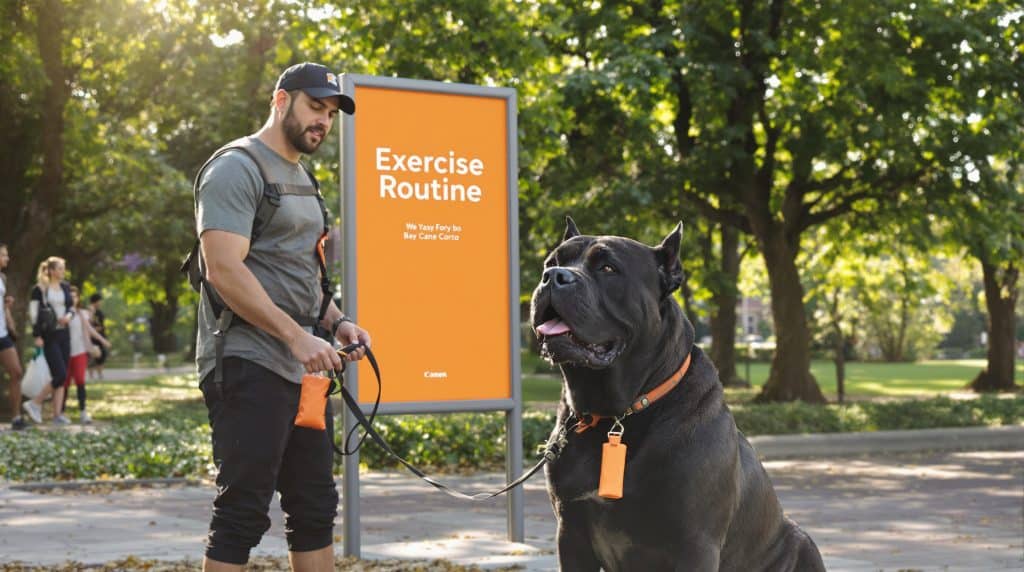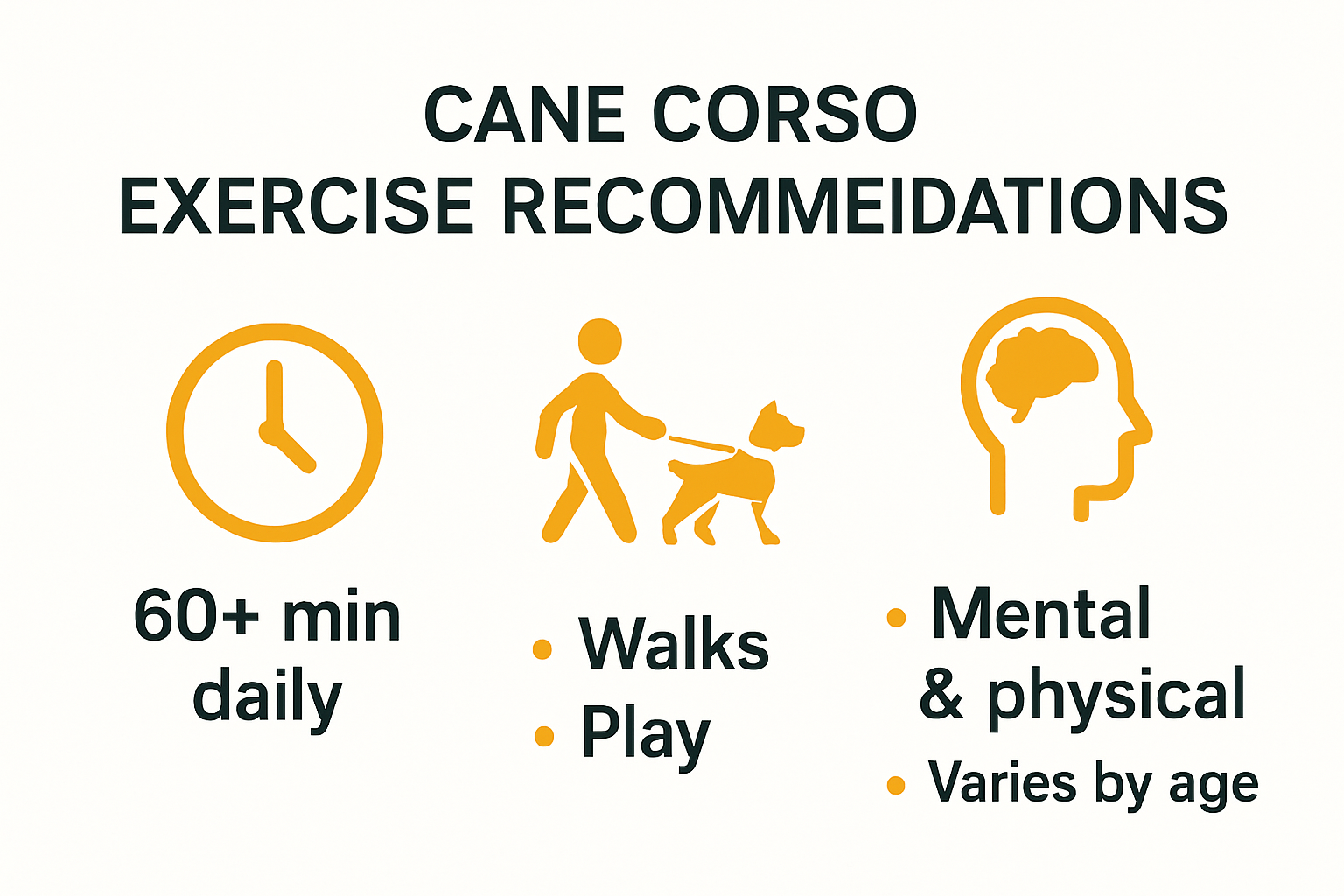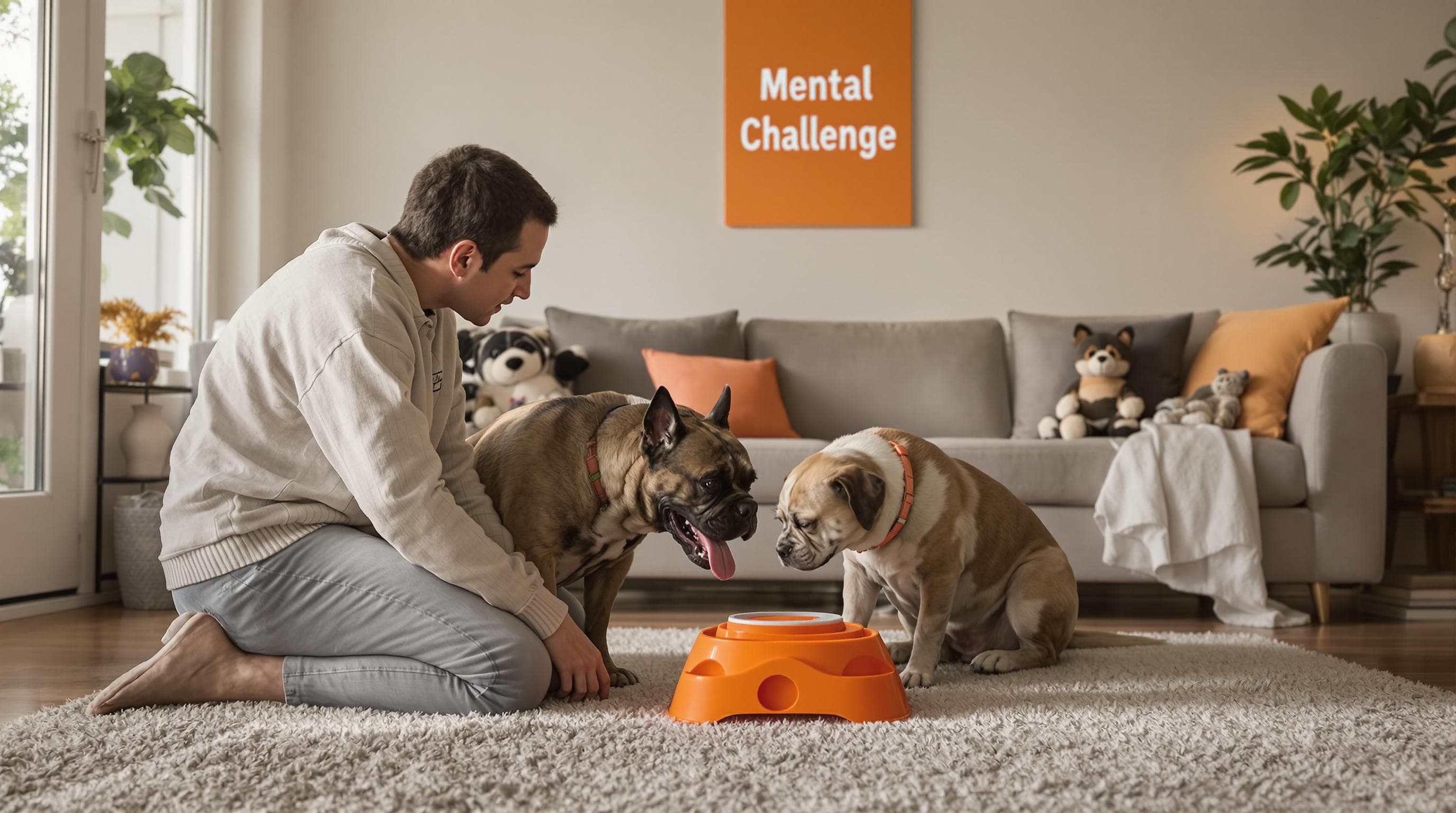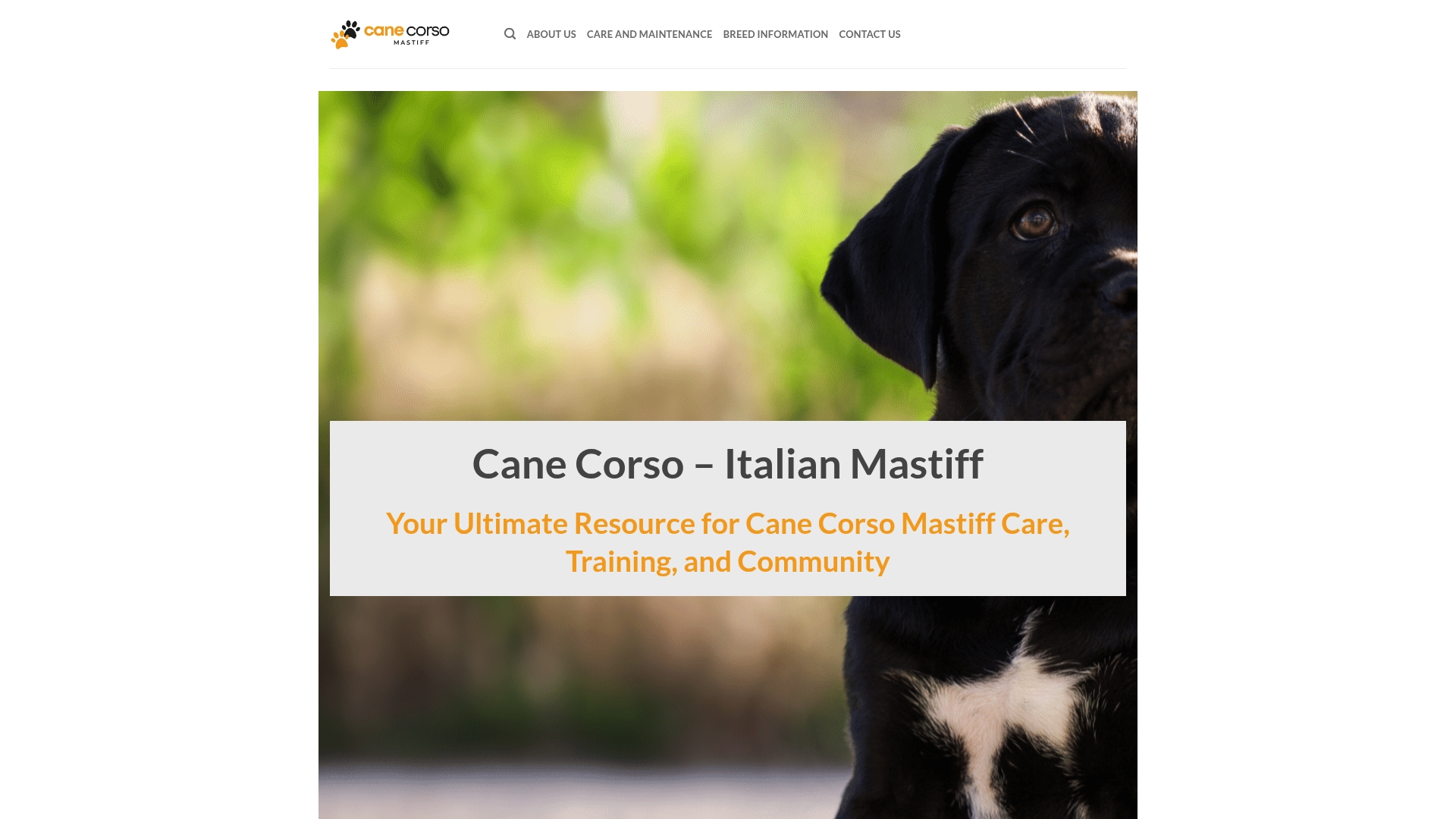Cane Corsos are famous for their strength and loyalty, making them a popular choice among dog owners who want a reliable protector. Still, most people are surprised to learn that an adult Cane Corso needs up to 90 minutes of exercise every single day. That seems like a lot for a dog, right? The real twist is that mental challenges matter just as much as physical activity for this breed, and skipping either one can quickly lead to some very unwanted behaviors.
Table of Contents
- Understanding Cane Corso Exercise Needs
- Best Daily Activities For Cane Corsos
- Safe Exercise Tips For Guard Dog Breeds
- Adapting Exercise For Puppies And Seniors
Quick Summary
| Takeaway | Explanation |
|---|---|
| Cane Corsos require 60-90 minutes of daily exercise. | To maintain both their physical health and mental well-being, owners must provide consistent and structured physical activity that engages the dog’s natural instincts. |
| Mental stimulation is crucial for preventing destructive behaviors. | Activities that challenge the dog’s cognitive abilities, such as puzzle toys and obedience training, are essential for a balanced exercise routine. |
| Exercise regimens must adapt for puppies and seniors. | Puppies should start with short walks at three months old, while senior dogs need low-impact activities to maintain muscle strength and joint mobility. |
| Controlled exercise strategies are vital for guard breeds. | Ensuring exercises prevent overstimulation and allow for behavioral management is critical for maintaining emotional control and discipline. |
| Individualized exercise plans are necessary for each dog. | Tailoring exercise routines to fit the unique needs, age, and health of each Cane Corso ensures optimal well-being and avoids potential injuries. |
Understanding Cane Corso Exercise Needs
Cane Corsos are powerful working dogs with substantial exercise requirements that demand an owner’s dedicated commitment. These muscular Italian mastiffs were originally bred for guarding and working purposes, which means their physical and mental stimulation needs are significantly higher than many other dog breeds. Understanding their exercise needs is crucial for maintaining their physical health, mental well-being, and preventing potential behavioral issues.
Physical Characteristics and Exercise Requirements
The Cane Corso’s robust physique demands consistent and structured physical activity. Our comprehensive exercise guide reveals that these dogs require approximately 60-90 minutes of daily exercise. Their muscular build and working dog heritage mean they thrive on activities that challenge both their body and mind. Unlike smaller breeds, Cane Corsos need more than casual walks they require intense, purposeful exercise that engages their natural instincts.
According to research from canine behavior experts, Cane Corsos were historically used as guard dogs, which means they have an inherent drive to be active and protective. Their exercise routine should incorporate activities that simulate their traditional working roles, such as structured training, long walks, and interactive play that keeps them mentally stimulated.
Mental Stimulation and Exercise Dynamics
Exercise for a Cane Corso is not just about physical movement but also about mental engagement. These intelligent dogs require activities that challenge their cognitive abilities and prevent boredom. Without proper mental stimulation, Cane Corsos can develop destructive behaviors or become anxious. Interactive games, obedience training, and puzzle toys are excellent ways to complement their physical exercise routine.
As veterinary behaviorists note, maintaining a lean and muscular physique is essential for this breed. Their exercise should focus on building strength, endurance, and providing controlled outlets for their natural protective instincts. Owners should design exercise plans that include variety walking, running, hiking, and structured play to keep their Cane Corso physically and mentally satisfied.
The key to successful Cane Corso exercise is understanding that these are not casual companion dogs but working animals with deep-rooted physical and mental needs. By providing consistent, challenging, and engaging exercise routines, owners can ensure their Cane Corso remains healthy, balanced, and a true companion.
Best Daily Activities for Cane Corsos
Cane Corsos are high-energy working dogs that require a diverse and engaging daily exercise routine to maintain their physical and mental health. Unlike casual companion breeds, these powerful Italian mastiffs need structured activities that challenge their intelligence, strength, and natural working instincts. Our comprehensive exercise strategies help owners design optimal activity plans that keep their Corso physically fit and mentally stimulated.
Structured Physical Exercise
Daily exercise for Cane Corsos should be comprehensive and varied. According to canine fitness experts, an adult Corso requires approximately 90 minutes of proper exercise per day. This exercise regimen should include activities that leverage their natural athletic abilities and working dog heritage. Long walks, jogging, hiking, and structured training sessions are excellent ways to meet their physical needs.
For puppies, exercise requirements differ slightly. Veterinary recommendations suggest starting with short 5 to 10-minute leashed walks when the puppy is three months old, gradually increasing duration and intensity as they grow. This approach helps prevent joint stress while building endurance and establishing exercise habits.
Mental Stimulation and Interactive Activities
Physical exercise alone is insufficient for Cane Corsos. These intelligent dogs require mental challenges that prevent boredom and destructive behaviors. Interactive games, puzzle toys, and obedience training are crucial components of their daily routine. Activities that engage their protective instincts and problem-solving skills can include tracking exercises, agility training, and structured play that mimics their historical guard dog roles.
As canine behavior experts note, Cane Corsos have a strong tendency to stick close to their owners and remain vigilant. Owners can capitalize on this trait by incorporating training exercises that challenge their cognitive abilities while reinforcing their natural protective instincts. Scent work, advanced obedience training, and controlled socialization can provide excellent mental stimulation.
The key to a successful daily activity plan for Cane Corsos is balance and consistency. By combining structured physical exercise with mentally engaging activities, owners can ensure their Corso remains healthy, happy, and well-adjusted. Remember that each dog is unique, and exercise routines should be tailored to the individual dog’s age, health, and energy levels.
To help owners quickly review activity ideas, the following table summarizes recommended daily activities for Cane Corsos, indicating whether they primarily target physical or mental stimulation (or both):
| Activity | Physical Stimulation | Mental Stimulation | Notes |
|---|---|---|---|
| Long walks/jogging | ✓ | – | Build stamina, can be structured |
| Hiking | ✓ | ✓ | New environments add mental challenge |
| Structured play (fetch, tug) | ✓ | ✓ | Interactive, channels energy |
| Obedience training | – | ✓ | Enhances discipline and focus |
| Puzzle toys/games | – | ✓ | Prevents boredom, exercises mind |
| Agility/tracking exercises | ✓ | ✓ | Utilizes problem-solving and athleticism |
| Scent work | – | ✓ | Engages nose and mind, encourages focus |
Safe Exercise Tips for Guard Dog Breeds
Guard dog breeds like the Cane Corso require specialized exercise approaches that balance physical activity with controlled behavior and mental discipline. Our stress-free exercise guide provides critical insights into maintaining safety and effectiveness during training and physical activities.
Controlled Physical Engagement
Exercise for guard dog breeds demands a strategic approach that prevents overstimulation and potential aggressive responses. According to Texas A&M AgriLife Research experts, preparing guard dogs for training requires ensuring they have sufficient exercise to maintain a calm and receptive mental state. This means designing workout routines that help release energy while maintaining emotional control.
Key controlled exercise strategies include structured activities that challenge the dog physically without triggering excessive protective instincts. Activities such as structured walking, controlled fetch, and obedience-based games can help channel their natural guarding tendencies into productive energy expenditure. The goal is to create exercise experiences that reinforce discipline and strengthen the bond between the dog and handler.
Behavioral Management During Exercise
Safety in guard dog exercise extends beyond physical activity to comprehensive behavioral management. XINSURANCE canine behavior specialists emphasize the critical importance of bite inhibition and controlled aggression. Owners must implement positive reinforcement techniques that guide the dog’s natural protective instincts without encouraging inappropriate aggressive responses.
Desensitization training plays a crucial role in exercise routines for guard dog breeds. This involves gradually exposing the dog to various stimuli in controlled environments, helping them learn to remain calm and focused despite potential distractions. Techniques might include practicing commands during walks, introducing controlled socialization scenarios, and using reward-based training that reinforces calm behavior.
Professional trainers recommend breaking exercise into segments that alternate between physical activity and mental stimulation. For Cane Corsos, this could mean combining a brisk walk with obedience training, followed by puzzle-based activities that challenge their intelligence while maintaining emotional regulation.
The ultimate objective of safe exercise for guard dog breeds is creating a balanced, confident companion who can distinguish between genuine threats and everyday interactions. By implementing thoughtful, structured exercise routines that prioritize both physical fitness and emotional control, owners can develop a guard dog that is both protective and predictable. Each training session becomes an opportunity to reinforce positive behaviors and strengthen the critical bond of trust between the dog and its handler.
To provide a clear comparison of safe exercise approaches for Cane Corsos depending on their behavioral needs, the following table outlines some effective strategies and their primary benefit:
| Exercise Strategy | Primary Benefit |
|---|---|
| Structured walks | Releases energy, reduces overstimulation |
| Controlled fetch games | Channels instinct, reinforces discipline |
| Obedience-based games/training | Promotes focus and emotional control |
| Desensitization training | Builds calmness around distractions |
| Reward-based socialization | Reinforces positive interactions |
| Alternating physical and mental activities | Balances energy, prevents negative reactions |
Adapting Exercise for Puppies and Seniors
Cane Corsos require specialized exercise approaches that adapt to their life stages, with dramatically different needs for puppies and senior dogs. Our low-stress exercise guide provides essential insights into creating age-appropriate fitness strategies that maintain health and prevent potential injuries.
Puppy Exercise Considerations
Puppies demand a carefully structured approach to physical activity that supports their developing bodies. According to canine development experts, Cane Corso puppies can begin structured exercise at three months old, starting with short 5 to 10-minute leashed walks. The key is gradual progression and avoiding high-impact activities that could damage developing joints.
Critical guidelines for puppy exercise include avoiding activities that involve excessive jumping, running on hard surfaces, or navigating stairs before 12 months of age. These precautions protect the puppy’s developing skeletal structure. Soft surface walks, gentle play, and short training sessions become the cornerstone of early physical development. Mental stimulation through puzzle toys and brief obedience training can complement physical exercise, ensuring the puppy develops both physically and mentally without overexertion.
Senior Dog Exercise Management
PetMD veterinary specialists recommend that senior Cane Corsos should receive 30 to 60 minutes of daily exercise, carefully tailored to their individual health status. As dogs age, exercise becomes less about intensity and more about maintaining muscle strength, joint mobility, and cognitive function. Low-impact activities like gentle walks, swimming, and modified play sessions become crucial for senior dog well-being.
Managing exercise for senior Cane Corsos requires close veterinary consultation and constant observation. Owners should watch for signs of fatigue, joint stiffness, or decreased mobility and adjust activities accordingly. Shorter, more frequent walks replace long, strenuous exercise sessions. Incorporating gentle stretching, massage, and range-of-motion exercises can help maintain muscle tone and joint flexibility.
The transition between puppy and senior exercise stages is gradual, requiring owners to be attentive and responsive to their Cane Corso’s changing physical needs. By understanding and implementing age-appropriate exercise strategies, owners can ensure their Cane Corso maintains optimal health throughout its lifetime. The goal remains consistent: providing physical activity that supports the dog’s overall well-being while preventing unnecessary strain or potential injury.
Remember that each Cane Corso is an individual. What works for one dog may not work for another, making personalized approaches and veterinary guidance essential in developing the most effective exercise routine.
Frequently Asked Questions
What is the recommended daily exercise duration for a Cane Corso?
How can I mentally stimulate my Cane Corso during exercise?
Should I adapt my Cane Corso's exercise routine for puppies and seniors?
What are some safe exercise tips for my Cane Corso?
Struggling to Keep Your Cane Corso Active and Balanced?
Exercise for Cane Corsos is never simple. This dedicated breed demands more than a daily walk. The article revealed just how critical it is to combine structured physical workouts with mental stimulation to prevent destructive behaviors and keep your Cane Corso healthy. Many owners feel overwhelmed by the challenge of designing the right routine and worry about managing their dog’s powerful instincts safely. Does this sound familiar? If you’re looking for real answers and proven methods, you are not alone. Visit our dedicated Cane Corso training resource for strategies tailored to your dog’s unique needs.
Your journey with your Cane Corso deserves expert support and up-to-date solutions. Discover practical exercise plans, behavior tips, and tools trusted by the Cane Corso community at Cane Corso Mastiff. Dive into our Training and Behavior archives to turn today’s exercise frustrations into lifelong confidence and harmony. Take the next step now and see the difference for yourself.
Recommended
- Cane Corso Exercise Without Stress: Easy Routines for 2025
- Cane Corso Exercise Routine: Essential Guide for Owners 2025
- Best Dog Food for Cane Corso: Top Picks & Feeding Guide 2025
- Why Dogs Need Exercise: Essential Guide for Cane Corso Owners 2025




